These are attic stairs in one of my customers homes. He asked me if I thought they were safe. One look at them and I told him emphatically that I thought they were quite dangerous.
It’s not easy to see in the picture, but they’re installed in a sloped part of the ceiling so that the stairs are at a much shallower angle than they’re designed for. What this means is that any weight on the stairs causes the hinged part of the stairs to open up (see second pic). At this point, all of the weight is being supported by the articulating arms that the stairs pivot on. They’re really not designed to carry much more than the weight of the stairs themselves. The weight of the person should be transferred to the floor. That’s not happening here.
It looks like someone (before the current owners) had tried to use a small barrel bolt to somehow restrain the two sections. That’s certainly not going to work.
I think the only real solution is to replace these stairs with something that’s intended for this situation like maybe telescoping stairs, but even telescoping stairs probably aren’t intended for such a shallow angle.
So, does anyone have any ideas to either make these stairs safe(er) or know of a product that would work in this situation? At the moment, I’m stumped and I’m not touching this hazard unless I’m 100% confident that I can make them safe.
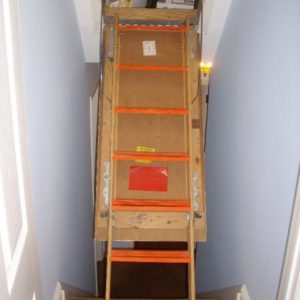
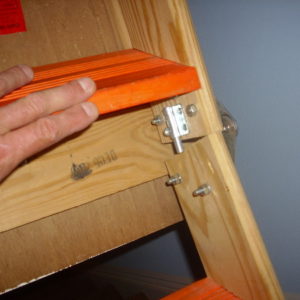
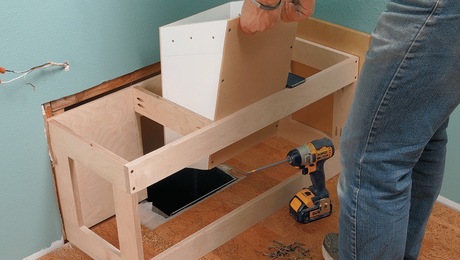
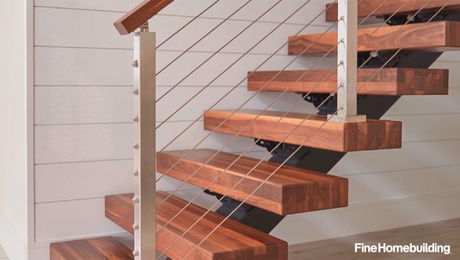


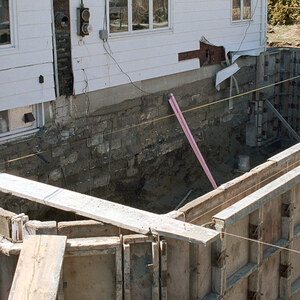













Replies
bump
Bottoms could be cut, blocking could be added. Granted the first step might be higher, but this would get the pivot point to close when fully extended and take the brunt of the weight off of the hinge. How often are these stairs used?
Thanks. I thought of that.
Bottom rails are too close to the steps to cut them and even if I could, because of being installed in a sloped ceiling, they wouldn't swing any closer to vertical anyway.
Can you reframe the opening above the ceiling so that you can rotate the stair "assembly" to be level when closed (which should give you the correct pitch when opened) and then build out the access panel to be flush with the ceiling?PaulB
http://www.finecontracting.com
I can't frame the higher end down because of limited headroom and I can't frame the lower end up because that would put it above the attic floor.
You may have stated that this can't be done, but where the ladder is attached in the ceiling needs to be raised up the slope getting you more over head of the landing to get your safe angle. When I put mine in in atypical application I ordered it to the closest dimension above my ceiling height and then it instructs you to cut the legs to fit, a couple of inches max probably.
As others have stated, you'd be better off to make suggetstions and let the home owner deal with it. Can't remember how long ago builders I worked with quit putting in attic access ladders due to liablility of home owners stepping through ceilings and worse.
I'm kind of morbidly curious of what all the junk is sitting on up there.
I'm kind of morbidly curious of what all the junk is sitting on up there.
I can't satisfy your curiosity, but I can tell you, based on the rest of the house, that these people are pack rats. It's not a big house and they don't do a good job of keeping clutter under control.
In fact, the job I just finished for them was to build a closet in the basement for additional storage.
But, they are the nicest people you'd want to meet or work for.
Maybe a "box" that sits on top tread?http://www.tvwsolar.com
We'll have a kid
Or maybe we'll rent one
He's got to be straight
We don't want a bent one
He'll drink his baby brew
From a big brass cup
Someday he may be president
If things loosen up
Maybe a "box" that sits on top tread?
Can you elaborate on that.
If it were my house, I would probably remove the stairs, but leave the hatch. Then, I would make a ladder similar to the kind used for bunk beds and drop it in place whenever I needed attic access.
So in theory most of the weight when standing on the ladder is at the top at hatch. Can't say that I've ever seen a pull-down installed in a sloped ceiling. You would need to frame the attic opening horizontal with the floor to make a stair work here, so to install correctly you would have a recess condition at the ceiling for the stair.
IMHO, I wouldn't touch them. Your liabilty is too high. Specially if you cut them. Ladders are designed to at a specified angle. Beyond that, the stress incresses as you go more horizontal
But, if i was to do anything, it would be at the center hing pivot. I would not cut it, but add and wedged block so the both parts of the ladder can compress on each other. Cutting it and redrilling would weaken the sides. I would also CYA and get something from the manufacturer
I'm not sure how a wedge would help. The gap you see in the second picture is there because I'm pushing on the stairs to simulate the weight of a person. Of course, I'm only pushing with a mere fraction of the weight of a person.
oops your right.
or should I say DUH, my bad...
how about a braidedcable that mounts at the hinge area and attaches to the joist on both sides to prevent the center from sagging?
A cable support would work.
However, pull-down stairs are already narrow and cable(s) would make them even narrower and possibly introduce another kind of hazzard.
I do creative repairs very often, but I have to be extremely careful with this one because of the potential liability.
I think you're right about replacing them --
1), they don't fit, and,
2), who knows how much they've been stressed and weakened.
Fix 'em, and they're your fault!
Precision Ladders makes the Super Simplex, which is even available in a fire-rated version. That's a good one to know about.
Bessler makes a one-piece stair that slides up and stores half on it's hatch, and half on the attic floor. I've worked on one of these. They're more substantial than most, and have a handrail.
The Bessler is custom-made for each situation, but I'm sure the one-piece wouldn't work with a sloped ceiling. They make a Space Saver that folds, though.
I'd envision you having to make a full-size pattern out of 1x that the stair company itself could work from to take their own measurements -- one stick lying on the landing, another pressed to the ceiling, maybe a vertical leg straight down from the far end of the ceiling opening to the stairs below.
Bessler is in Memphis, though... a folding template, UPS?
Resource Conservation Technology (the people who make that weatherstripping router that Sphere and I use) makes a nice airtight unit, and they're closer, in Baltimore.
Other than that, I'd say new location where the ceiling is level (best), or create a level spot at the existing location (ugly?).
Keep us posted!
AitchKay
Thanks, I just called Bessler and they said, with certaintly, that they don't have anything that would work on a sloped ceiling.
As mentioned do not touch them in a million years. You WILL be liable anything ever happens. The only fix is to relocate them. I've never in my life seen a set of attic stairs like that before. There has to be a code violation for this. Never thought I would ever see something like that.
Yeah, it's amazing how "inventive" some homeowners can be.
These stairs were not installed by the current owners. The reason that they're there is because a previous owner stole space from a "real" set of steps in order to put in a closet.
Bet there is a code violation for this too.
bet that could hurt...
Life is not a journey to the grave with the intention of arriving safely in a pretty and well preserved body, but rather to skid in broadside, thoroughly used up, totally worn out, and loudly proclaiming<!----><!----><!---->
WOW!!! What a Ride!
Forget the primal scream, just ROAR!!!
"Some days it's just not worth chewing through the restraints"
That's the oldest trick in the book -- pulled that one on my MIL -- what a laugh1
Didn't know Salvadore Dale (?) designed houses....
Well, there are few things as scary as a set of attic stairs that attempt to fold closed when you use them.
Other, maybe, than all the "stuff" that is right there in the way of the stair's landing.
I'm also surprised that no previous owner screwed a hank of the bent flat metal chain to the side of the hinged stair and then up to the head of the opening. I've seen this "out in the country" where no one read the instructions and trimmed the excess length off the stringers to fit (so that you have 8' of open stair with a 7'-9" floor-to-ceiling height--which prevents having the stair ever being fully "open").
Now, from the first photo, it looks like there's almost enough left of the folding stringer to trim to better close the stair when open. But, it will be very close to that bottom tread. And, as a eyeball guess, it'll wind up near the top tread of the stairs--not good.
As the others have said, flee this with all available haste. Even if a good answer in terms of access equipment coupld be found--what do you du when you find out that the attci "sill" is a single 2x4" Or the attic floor is not properly "headered" off across the stairwell opening?
Really, walk away. Isn't that your phone ringing? A text? Beeper going off? Doctor's appointment?
Ha! Well said, lol.
Not saying I would ever do this<G>
Looks like the pivoting part of the stairs needs to pivot some more to close the gap between the sections. A box on the top tread could extend the landing far enough so the feet could get to the right position.
I'd also suggest lag type screws through the plates (if there are any) at the hinge end, and through the hinge/spring plate.
Nother option might be to lose ladder part off the door all together, and make a new, independent ladder that sits on the stairs.
Of course, a lot depends on how many stone these clients are, and how often they use that mousetrap<G>
We'll have a kid
Or maybe we'll rent one
He's got to be straight
We don't want a bent one
He'll drink his baby brew
From a big brass cup
Someday he may be president
If things loosen up
Thanks. I understand your suggestion.
I think I'm going to propose to them that these stairs be abandoned. I can make a free-standing one-piece ladder (similar to the kind used on bunk beds) that would be economical and safe. It could still use the same hatch.
The only down-side is that it would need to be stored somewhere. Even though we're only talking about a 7' ladder, I don't think they'll go for it since their house is already a bit shy on space. It would be awesome if it could slide up into the attic when not in use. I need to give a lot of thought on how to do that.
There are disappearing stairs that do just that...http://www.tvwsolar.com
We'll have a kid
Or maybe we'll rent one
He's got to be straight
We don't want a bent one
He'll drink his baby brew
From a big brass cup
Someday he may be president
If things loosen up
But not for sloped ceilings. They lie horizontal, half on the LEVEL hatch, half on the attic floor.This one would have to tip well past level, parallel with the sloped ceiling, which would mean that the attic-floor portion would have to hang down below the attic floor, down into the living space.AitchKay
I think you misinterpret. Even if the bottom section opened all the way it won't "lock", so the top section WILL carry the weight, regardless.
In properly installed attic stairs, the weight is carried much like an ordinary ladder. Some of it is leaning against the header opening (where the hinge is) and most of it is carried down the rails to the floor.
Even though the hinged parts aren't "locked", they still transfer the weight down the rails.
The stairs I posted about do not transfer any weight to the floor at all. It would be like trimming attic stairs so that they never even reached the floor... only worse. Worse because the angle that they're installed at provides tremendous leverage that needs to be resisted by the spring arm resting against the pivot point of the ladder arm. (names are mine).
View Image
A standard attic ladder is longer and in 3 sections. The bottom two "lock" so that weight is transferred down to the floor, but joint between the top two (which is what you have left after the ladder was cut off) bends the other direction. Once you're near that joint virtually all the weight is supported from the top. The only difference with this setup vs normal is that the ladder is shorter so you spend proportionally longer (essentially all the time) on the top-supported section.You could cut off the bottom section a few more inches, to try to get the joint to close better, but it won't make a lot of difference -- attic ladders are "supposed" to be that flimsy.
A strong nation, like a strong person, can afford to be gentle, firm, thoughtful, and restrained. It can afford to extend a helping hand to others. It's a weak nation, like a weak person, that must behave with bluster and boasting and rashness and other signs of insecurity. --Jimmy Carter
Once you're near that joint virtually all the weight is supported from the top.
I took another look at my own attic stairs and you're right. I didn't realize, once you're on that section, how little weight is actually transferred down to the floor. But I still don't think that makes the stairs in question "safe". The angle is too shallow.
If you could find a telescoping ladder then you could have it land on one of the lower steps bringing you much closer to vertical as should be. Of course, pulling down the ladder and then descending the steps only to go up a ladder is probably still not the best safety solution.
Anyway to use the hatch if you reverse the whole thing? In other words, have the ladder attached to the upper part of the hatch and then extend down the steps to the lower landing? Any room for them the get into the attic from that direction
It's hard to tell from the pictures what the angle of the stairs is. If the stair is a standard unit and the arms weren't modified somehow for the angle then it would be more of a ramp and, as you suggest, unsafe.
A strong nation, like a strong person, can afford to be gentle, firm, thoughtful, and restrained. It can afford to extend a helping hand to others. It's a weak nation, like a weak person, that must behave with bluster and boasting and rashness and other signs of insecurity. --Jimmy Carter
It would take some doing. I would ramp out the rails of the top section just a little more than required to close the hinge joint. Think of a wedge under each rail of the top section from bottom of the top rail tapering to zero at the top of the rails. Of course you would need to redo the anchor straps with longer material and use generous construction adhesive installing the wedges under the rails.
Further; I do not see any hand rails on the stair wells, definitely not code. Only a matter of time and someone will break something on their body.
Virginbuild
How about this?
http://www.calvertstairs.com/id35.html
I got nauseous looking at the pic.
And I'm a crazy guy that will do almost anything.